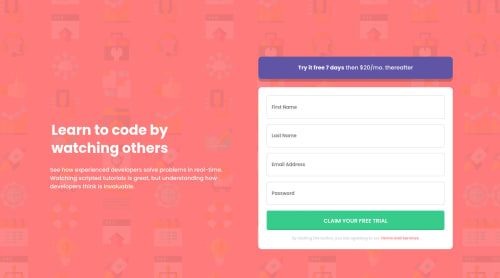Intro component signup form master

Solution retrospective
Would love to get feedback
Please log in to post a comment
Log in with GitHubCommunity feedback
- @DavidMorgade
Hello Mohamed! congrats on finishing the challenge!
Your HTML and CSS looks perfect for me, also the validation of the form is doing its job.
I would like to give you a little advice to improve the user experience, you can add some
transitionsto your buttons to get a better look of your web and make it look even more modern!Try adding to your buttons
transition: background-color 0.5s ease;, and you will see that the hover goes a lot smoother than before!Hope my feedback helps you!, Good job and keep going!
Marked as helpful - @vanzasetia
Hi, Mohamed Metwally! 👋
Congratulations on finishing this challenge! 🎉
Here are some suggestions for improvements.
- Input element always needs a label. In this case, you can use
aria-labelto give labels to the input elements. - On my desktop view,
1280pxwidth, the layout form is filling the entire page. It should have enough space to create the desktop layout.1440pxwidth for the desktop layout is too late. - Use single class selectors for styling whenever possible instead of
id.idhas high specificity which can lead to a lot of issues on the larger project. It's best to keep the CSS specificity as low and flat as possible. - The native HTML validation for the email input is not good enough. If you try input
d@dthen it is a valid email. A valid email should have the top-level domain (e.g..com,.org, etc). So, I suggest trying to validate the email input with regular expression. - There are some
!importantkeywords in the stylesheet. This could be a sign there is something wrong with the stylesheet if you find yourself start using it. So, try to write the styling without!important.
Hope this helps! 🙂
- Input element always needs a label. In this case, you can use
Join our Discord community
Join thousands of Frontend Mentor community members taking the challenges, sharing resources, helping each other, and chatting about all things front-end!
Join our Discord